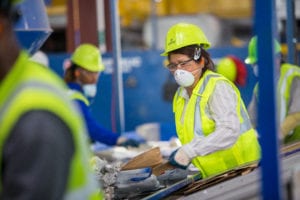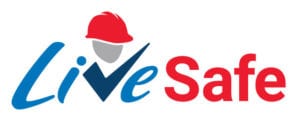Recycling facilities are altering lines and adding equipment to keep up with market needs. But how do you ensure MRF workers keep pace with the changes?
As seen in Resource Recycling, April 2020
2020 Trend: Your MRF Will Change
Industry leaders, experts and pundits believe 2020 will be another year of consolidation and M&A activity within the waste and recycling industry. Improving the efficiency of recycling is another big topic of discussion. Reducing injury and safety incidents is a perennial trend. And a fourth trend is the growing addition of robotics and AI in recycling plants. MRF operators, industry groups and legislators continue to look for ways to cut waste, improve environmental sustainability, and remain profitable amid this period of change.
A typical way of addressing these trends is to make structural changes that enhance productivity, cut contamination rates, and reduce safety incidents. Some common approaches are:
- Adding new lines to handle different types of material
- Upgrading to more modern machinery to improve efficiency
- Investing in robots to support sorting and baling
- Consolidating two or more MRFs into a single operation to reduce cost
The goal for any plant and the primary driver of change is to produce marketable material at a quality and volume that achieves a net positive cost per ton. The expectation is that technology and equipment enhancements will deliver results.
What can happen, however, is that MRFs get the same results as they did previously. Why? Not because the equipment is faulty, or plants are ill-equipped.
It’s because the human side of process improvement isn’t accounted for.
 The Human Factor When Facilities Change
The Human Factor When Facilities Change
Thoughtful planning about people starts before new equipment arrives and the transition or shutdown period begins.
Start with a plan for handling your current employees — those who leave and those who stay while you close or slow down during installation or reworking of the floor. Leadpoint has worked with dozens of MRFs during periods of change. We advise operators that they’ll lose half of their workforce when there’s a significant change or when there’s downtime that lasts longer than two days.
How can you ensure that your employees will be there for you after the change? Or are you OK with 80-100% turnover?
Communication is the key. Keep people in the loop so they are part of the change process and let them know the plan. When employees feel like they’re part of the process, their engagement and commitment will increase through the lead-up to a change and afterward.
Consider the labor cost of change. Will you pay a “stay bonus” or furlough all or some of your employees? Perhaps you can re-purpose or relocate these people to other tasks or locations. What’s your budget for retaining top performers? If your MRF relies on “day labor,” it’s tempting to think you can let the current crew go and simply bring in a new group of temps when you need them. This may seem efficient, but 100% turnover means you’ll lose whatever training and experience you’ve invested in.
In this period of low unemployment, keeping the people you have at work in roles that are challenging to fill in the best of times is one of the smartest decisions a company can make.
There’s also a reputational risk whenever you let an entire team of people go, even if they are temps. Word gets out among job seekers that you’re not a reliable employer, which can damage future recruiting efforts. That said, it’s wise to build a recruiting plan ahead of time to ensure you have the people you need on Day One of the new operation. Whether you’re hiring direct, working with a day labor company, or partnering with a full-time workforce provider, advance preparation is key.
Employee Training: During & After Change
Short periods of downtime create an ideal opportunity for training that prepares employees for success in a new environment. Remember, people only know how it used to work, not how the new system or process will operate. Equipment vendors can be valuable training partners, helping the team get to know new machines and achieve the system’s quality and production goals.
Encourage cross-functional training, including members of the management team. It supports problem-solving and allows for quick deployment of people to different assignments when needed.
Most important: training must help employees understand the big picture about their task. Commodity education is often overlooked. If people know what they are sorting and why, productivity and revenue will improve as a result.
Safety: First & Always
Hand speeds and bale counts are important metrics but can’t come at the expense of basic safety.
New equipment generally requires new safety training for every employee, including temps, and especially around LOTO, emergency evacuations and, walking-working surfaces.
Use periods of change to review and refresh all safety compliance topics.
For major retrofits, don’t overlook how new equipment and processes change the way employees work and move in and around the plant. Consider these areas for an in-depth safety evaluation:
- Are there enough emergency egress routes? Are they compliant?
- Have pedestrian routes changed? Do they conflict with forklift traffic, tip floor, or loading dock activity?
- Have you reviewed machine guarding requirements BEFORE start-up?
- Ensure you understand how to effectively Lock and Tag all energy sources. Know which disconnects control what sources.
- Consider whether your confined space program needs updating along with changes to the plant.
Finally, sites should use this time to evaluate and update their fall protection program and conduct a new industrial hygiene survey, with special attention to noise.
Maintenance & Downtime
New equipment and robotics generally work perfectly the day they’re installed – that’s the expertise and experience you’re expecting and paying for on Day One. Then comes Day Two. Your team needs to know how to clean the new system’s screens and optics daily. They must be able to identify wear points on belts, shafts, and bearings and know-how to report potential issues. Remember to think through how your workers will access the areas they need to maintain. Ask yourself, “Did we install maintenance platforms? Do we have adequate tie-off points for fall protection?” Cleaning, preventive maintenance, and consistent assessment are critical to the performance of a new system, and to the safety and productivity of the team. Early identification of issues and maintenance needs will reduce operational and mechanical downtime that can reduce your new system’s performance.
 The True Cost of Change
The True Cost of Change
Amid periods of structural change, MRF leaders must understand how to achieve the promised efficiencies from their new equipment or machinery. The cost of change is always greater than the base cost of equipment, robotics or facility construction. Getting the most out of new equipment or upgrades requires that managers, sorters, and other MRF personnel are thoroughly trained, performance is measured, and maintenance is done on schedule. It’s like buying an expensive sports car but not knowing how to drive. Subtle adjustments on the people side of the equation will dramatically improve production and reduce processing time. Bring a sense of urgency about the workforce to changes in your MRF to get the best results. It sounds simple, but if the machines aren’t running, you’re not making money.
Since 2000, Leadpoint has helped recycling companies maximize their workforce and improve the productivity, efficiency, and profitability of their operation with full-time employees embedded at MRFs nationwide. Based in Phoenix, the company takes the chaos out of MRF operations and optimizes performance for recycling organizations. Learn more here or call us at 888-205-1511.

